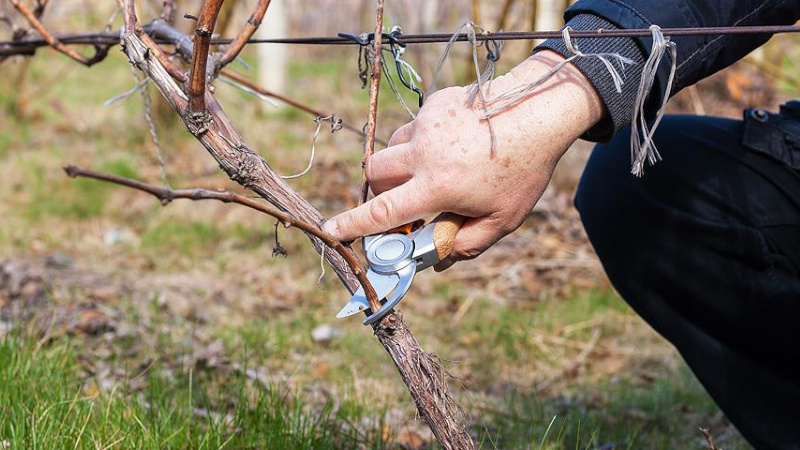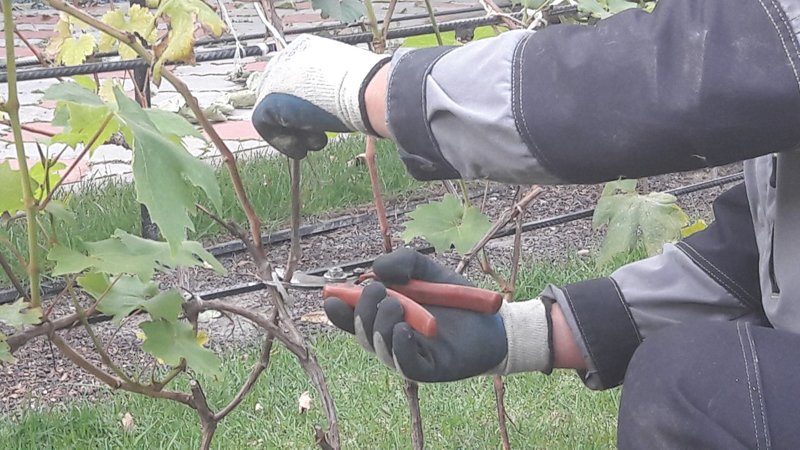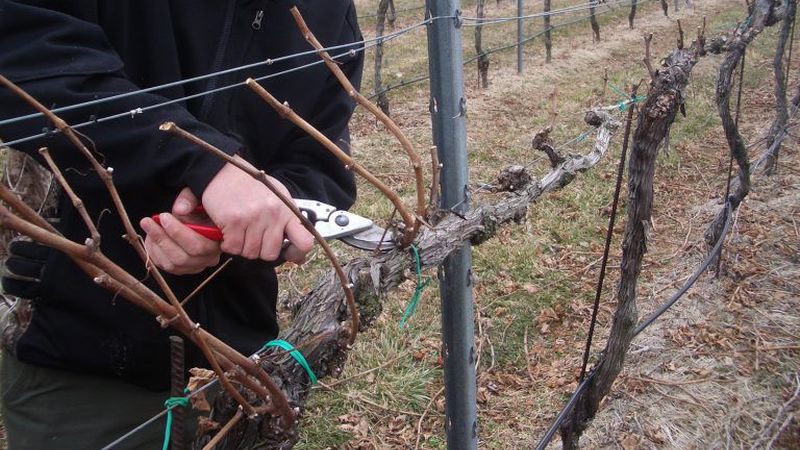When and how to properly prune grapes in the fall and care for them after the procedure
A beautiful and well-kept vineyard is not a whim of a gardener, but a necessity. Autumn pruning of the vine helps to achieve this result. In order for the procedure to follow all the rules, you need to know a few secrets. Read on to learn how to properly prune grapes in the fall.
The content of the article
Why cut grapes in the fall, what does it give
Experienced growers have become opponents of spring pruning over the years. It is noticed that pruning the vine in spring involves risks. The main one is the “cry of the vine”, which often destroys plantings. This phenomenon occurs if you miss the beginning of the spring sap flow and cut branches after waking up. Spring pruning is often the cause of vineyard death due to loss of juice. Autumn pruning carried out when the plant is already asleep and is completely ready for winter.

Is it necessary to trim
Pruning grapes in autumn has a number of benefits.... In addition to cleaning the vine from excessive thickening, it creates conditions for the formation of a large number of fruit buds on the branches, not vegetative buds. After the autumn pruning of the vineyard, several clusters grow on the vine. All of them are of high quality - dense, heavy, with large berries.
The task of autumn pruning is to redirect the forces of the plant to the establishment and nutrition of fruit buds, and not to the growth of the useless vegetative part. Each new vine needs 2 m² for full development, so cleaning is ruthless.
Optimal timing of the procedure
Timing of pruning in the fall depends not only on weather conditions, but also on the age and variety of the vine.
By region
Autumn pruning of grapes is carried out in regions where covering cultivation of wine berries is practiced. The procedure reduces the volume of branches and reduces the risk of injury to the plant during wrapping covering material.
On a note! Covering grape cultivation is practiced in regions where the winter temperature drops below –20 ° C for a long period.
The exact dates are determined by gardeners independently, based on weather conditions. Pruned at the first slight frost, within 1-2 days. In warm latitudes - in September - November, in the north - in early September. So the vine will not have time to freeze, the branches will remain flexible and will not break off under the pruner.
Lunar calendar

Adherents of the lunar calendar recommend carrying out garden work on pruning for the waning moon... The exception is plantings up to two years of age, when the growth of the vegetative part and the formation of the skeleton are in advantage.
When choosing a date according to the lunar calendar, the average daily temperature is also taken into account. Trimming works are carried out at an average daily rate of 0 ... + 3 ° C.
Types of trimming
During autumn pruning, 50 to 70% of the vine is removed.
Formative
The complete shaping of the bush is carried out in three years:
- First year of life. In the spring, at the time of planting, 2 leading buds are left on the seedling, which will become the basis of the bush. It is they who are subject to the first autumn shortening. 2 eyes are left on the first sleeve, 4 on the second.
- Second year of life. In the second year, full-fledged shoots grow from the left buds over the summer. On the long sleeve, two shoots are left in autumn and equal in length to the short one.The result is the same length for both sleeves. Stems located closer to the center clear up to 2 buds, on the periphery - up to 4. This is the future fruit arrows.
- Third year of life. The 4 extreme replacement knots are cut with a part of the sleeve. As a result, 1 link is obtained for two stems on each shoulder. The stems closest to the center are cut into 2 buds, the distant ones - by 4, as in the previous year.
The algorithm is kept for all subsequent years. For reinsurance, in the northern regions, 1-2 more buds are left on the shoots. If freezing has not occurred during the winter, they are removed in the spring.
The autumn molding of grapes is carried out in two stages:
- Before the start of frost, preparatory measures are carried out. 1-2 weeks before the main pruning, young, immature shoots are manually removed from the vine.
- With the onset of frost, the main formative pruning is carried out. During the events, radical removal is used.
An immature shoot differs from a mature one in a lighter color and thin skin. The healthiest and strongest branches are chosen for laying fruit-bearing shoots.
Anti-aging
There are secrets to rejuvenating an old, thickened or elongated bush. The main feeding vessels in such a vine are connected to the substitute shoots. If the shoots have grown, the overall nutrition of the bush is weakened. This means that trimming the side shoots in favor of the center is useless. To restore normal fruiting of the bush will help the elimination of central branches in favor of substitutes.
Sanitary
Sanitary pruning is carried out in the fall after harvest and, if necessary, in case of vineyard contamination. Sick, shriveled branches are subject to removal, regardless of their purpose and age. At the end of the sanitary measures, the planting process fungicidal agents:
- bordeaux liquid;
- copper sulfate;
- colloidal sulfur.
Any medicinal mixture is used on the day of preparation.
How to prune grapes correctly

Pruning grapes is a serious but uncomplicated undertaking. After 2-3 years, an inexperienced beginner understands the principle of forming a bush and easily copes with the task.
Required materials and tools
A minimum of tools are required to prune vineyards. To trim fragile branches, it is enough to prepare a pruner with rounded blades and short handles.
Attention! The pruning shears must be sharpened and the spring mechanism lubricated before use. Work in protective gloves made of dense fabric.
Pruning schemes
The vine is cut at the internodes. At two- and three-year-old sleeves, stumps up to 0.5 cm long are left to protect the wood from pests.
A typical fall pruning scheme looks like this:
- weak shoots (those with less than 7-8 eyes), spinning tops, fruiting links are removed from the vine;
- up to 8 strong shoots are left for fruiting;
- annual shoots on old bushes are removed;
- stepsons on fruitful arrows are shortened by 10-12%;
- no more than 30 eyes are left on one plant;
- replacement knots are formed from 5-6 year old shoots.
To simplify the autumn pruning of the plant, the bush is revised in the summer. For this, shoots suitable for development are selected and marked with a marker.
Step-by-step instructions for pruning for the winter
The process of pruning grapes is painstaking and lengthy. It is carried out in the morning, when the sun illuminates the plantings and the gardener sees all the shaded areas.
How to prune a vine in the fall:
- Conduct an overall assessment of the condition of the plantings.
- Remove dry, diseased, uncomfortable branches.
- Clear the head of the bush from the stumps of last year's formation.
- Prune leading vines with arrows.
- Cut out old branches without annual vines.
- Cut out weak shoots and tops.
- Truncate immature tops.
Slices are made in one motion towards the inside of the plant. At the end of the activities, the removed brushwood is removed from the site and burned to prevent the appearance of pests and fungal diseases.
Attention! The vine is cut to live wood so that the cut has a light green color.
Formation
During the autumn pruning of the vines, the formation of the skeleton is carried out. To do this, select the leading shoots and leave them in the correct order so that after growth the branches are ventilated and illuminated by the sun.
Attention! In regions with a harsh climate, 35-40% more fruitful eyes are left during formative pruning. In case of prolonged frosts, they will replace the dead eyes and help to get the expected harvest in full.
Pruning features
The nutritional system of young and old berry plants is fundamentally different. Young saplings let out juices first of all to the leading shoots. Old vines "take care" of the periphery.
Young grapes
When forming the skeleton of young grapes, the central parts are always cut out. This makes it possible to lay the skeleton of the correct shape with the optimal ventilation and lighting of the branches.
Old
Old shoots are cut in such a way as to shift the center to the edge of the bush. If more than 30 buds remain on one plant, one of the sleeves is removed completely.
Further care

Experienced gardeners have noticed that fungal diseases often affect unkempt vineyards. This is because the spores of the fungus settle in fallen leaves and winter safely until spring. With the onset of warmth, such plantations become infected and quickly die. To avoid such a situation, for the winter, fallen leaves and cut branches are removed and burned in the garden.
After pruning, a week before the shelter, a traditional top dressing grapes. They do it for the autumn digging of the soil at a distance of 1 m from the bush in the place of the main occurrence of the root mass. Consumption: 1 bucket of compost or rotted manure and 1 glass of ash per 1 m² of soil. After 2-3 days, water charging is carried out and the vine is covered until spring.
Conclusion
Pruning grapes in autumn makes the gardener's work much easier in spring. Peeled grapes are easier to cover for the winter, they are less sick and bear fruit efficiently. Branches cut before winter heal faster, the risk of "crying vine" and loss of selection seedlings is minimized.